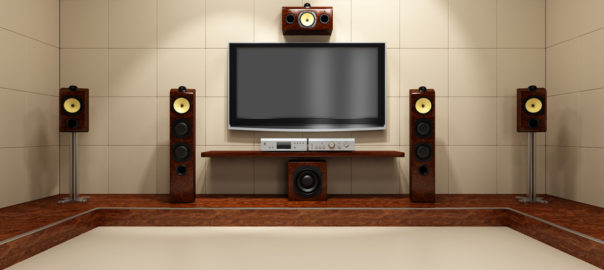Surround sound has been in existence for almost a century,1 and is included in all sorts of audio visual systems—from the latest in home theatre technology, to the best in car audio systems.
But what is surround sound, exactly? And when does it work best?
Let’s take a look at the ins and outs of getting the best surround sound setup for your home entertainment theatre.
How does surround sound work?
Surround sound is a broad term that refers to a configuration of three or more speakers, creating an effect that “surrounds” listeners with sound. A surround sound setup makes you feel like you’re in the middle of the action, with synchronised sound directed at you from the front, behind, and either side of you. Using the basic principles of surround sound, it would be easy to conclude that the best surround sound setup would consist of as many speakers as possible. But that’s not always the case. As with most things, surround sound works best when you focus on quality, rather than quantity, which we’ll address in a moment.
Speaker positioning for a surround sound setup
If you want to install a quality surround sound setup, your number one priority needs to be placement. And we don’t just mean random placement in all corners of the room. Sound systems are sensitive to the acoustics of a space, so you’ve got to think about how sound will react when it’s coming from the place you install your speaker. The surrounding surfaces shouldn’t be soft, otherwise they’ll muffle the sound. On the other hand, they shouldn’t be too hard or flat, otherwise the sound will echo and you’ll lose the precision surround sound effect. And, it goes without saying, never face your speakers into a wall or hard surface!
Ever wondered about surround sound headphones?
If sound systems come across as a bit complicated to you, you might consider surround sound headphones. But how do they work? After all, the whole premise of surround sound is that a minimum of three speakers are required. Well, thanks to the wonders of technology, that’s no longer the case: virtual surround sound has arrived. Virtual surround sound goes to the source of the sound, rather than its output, and applies complicated programs that filter the sound, so that it seems to be coming from numerous speakers and directions. The effect is remarkably similar to ‘true’ surround sound, and surround sound headphones are well worth a try.
Here are some other uses for virtual surround sound
Thanks to virtual surround sound, it’s not only headphones that are improving. In fact, virtual surround sound technology now extends to all manner of products, including sound bars, and even conventional inbuilt television stereos. Of course, you need to take the good with the bad; not all virtual surround sound systems offer a comparable experience. But on the higher end of the spectrum, you can achieve a realistic surround sound experience with only two speakers, thanks to virtual surround sound.
Get more bang for your buck with this surround sound setup
So what do we recommend? ‘True’ surround sound setups, or virtual ones? Well, it really depends on your budget and needs. Given that they only require two speakers, virtual surround sound setups might seem more affordable. But beware! Cheaper virtual surround sound units rarely offer a satisfying experience, and you’d likely be better off using that money to buy a high quality soundbar. In our view, it’s hard to beat the ‘true’ surround sound experience, but don’t let that discourage you from trying out some virtual options too.
References
- 1. The History of Surround Sound, Fluance
